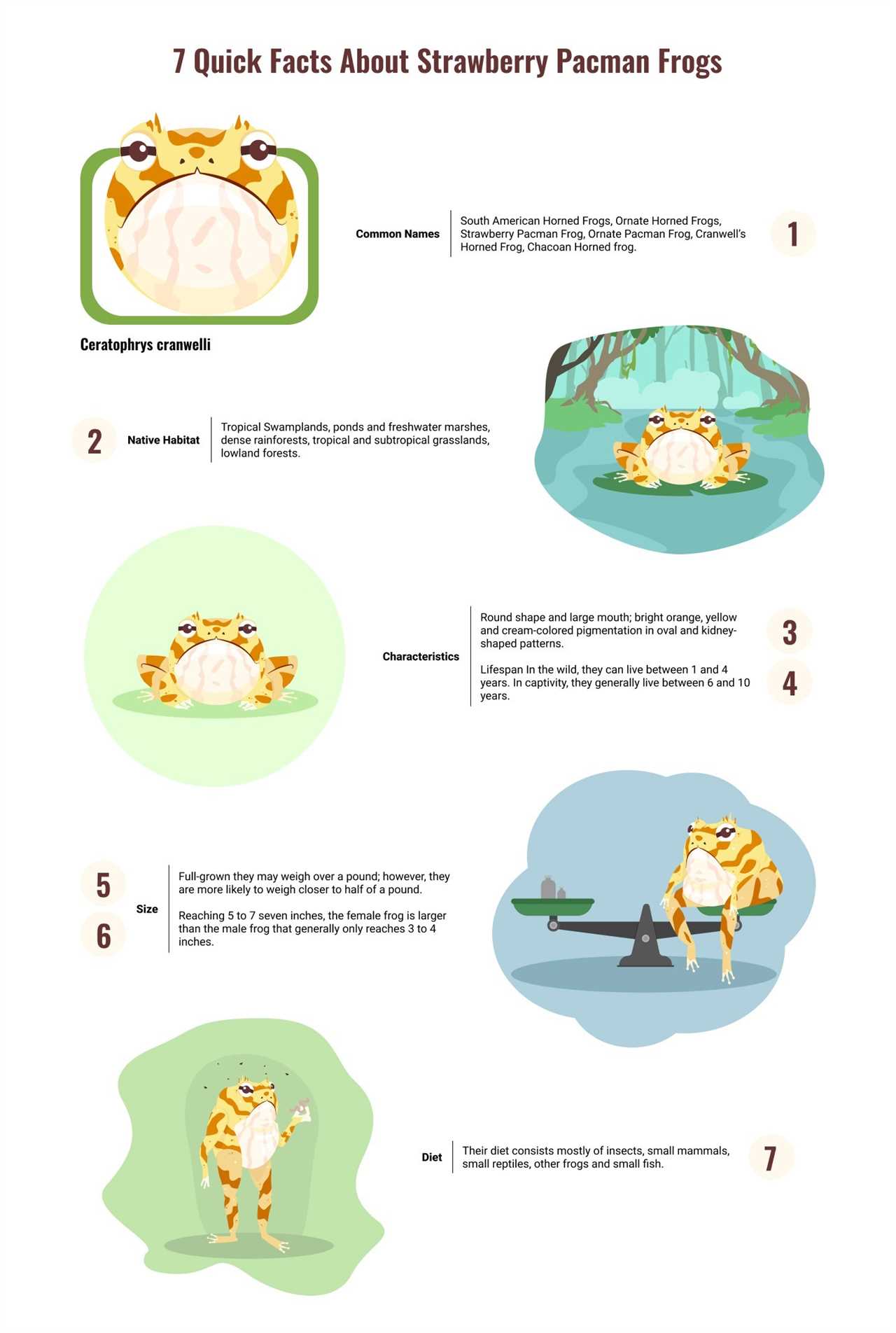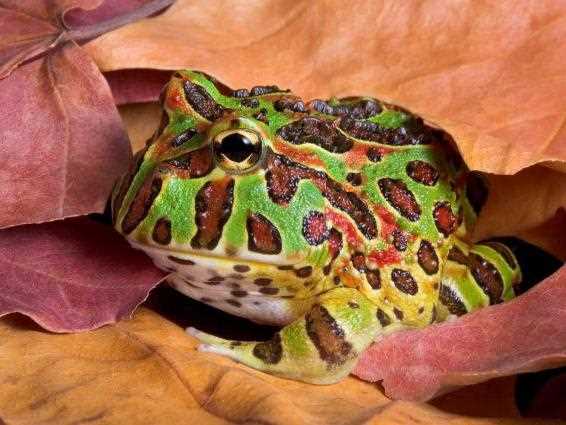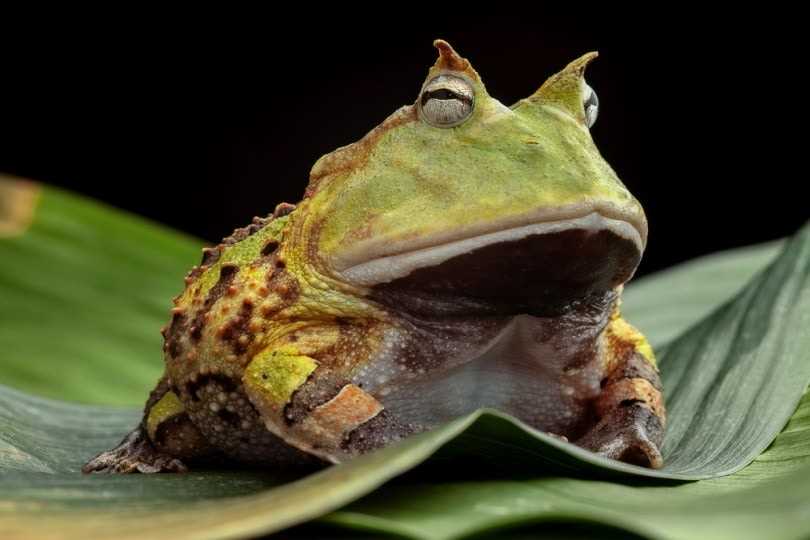
What are Pacman Frogs?

Pacman frogs belong to the Ceratophryidae family and are categorized under the genus Ceratophrys. They are medium to large-sized frogs, with females growing up to 7 inches in length, while males tend to be slightly smaller. These frogs have a stocky body with a wide mouth and skin that varies in color, ranging from green to brown and even yellow.
Pacman frogs are burrowers by nature and spend most of their time underground, waiting for prey to come within range of their powerful jaws. They have a unique feeding mechanism where they launch themselves at their prey, catching it with their large mouths and swallowing it whole.
Appearance and Habitat of Pacman Frogs
Pacman frogs have a distinctive appearance that sets them apart from other amphibians. They have a round, fat body with a flat head and large enticing eyes. Their skin is covered in small bumps and folds, giving them a rough texture.
These frogs are well-camouflaged in their natural habitat, which consists of the leaf litter and forest floor of the rainforest. They have the ability to change color to match their surroundings, allowing them to blend in and remain hidden from predators.
Pacman frogs are native to the various countries in South America, including Argentina, Brazil, Paraguay, and Uruguay. They can be found in the humid and tropical regions of these countries, particularly in areas with dense vegetation and bodies of freshwater.
These frogs inhabit the rainforest floor, where they dig burrows to create a safe and moist environment for themselves. They prefer areas with loose soil or sand, as it allows them to burrow easily.
The Natural Behavior of Pacman Frogs
Pacman frogs are primarily nocturnal creatures and are most active during the night. During the day, they remain hidden in their burrows, waiting for nightfall to venture out in search of food. Their burrows provide them with protection from the heat and predators, allowing them to stay cool and safe.
These frogs are solitary by nature and prefer to live alone. They are generally peaceful towards humans but may become aggressive if they feel threatened or provoked. When threatened, they can inflate their bodies and release a loud, hissing noise as a warning signal.
Being amphibians, pacman frogs have a permeable skin that allows them to absorb moisture from their surroundings. They require a humid environment to thrive and will often soak in shallow water or dig into the substrate to keep their skin moist.
In the next sections, we will explore the feeding habits, reproduction, and hibernation behavior of pacman frogs.
What Are Pacman Frogs?
Pacman frogs are named after the popular video game character because of their large mouths and round bodies. They have a unique shape and are easily recognizable with their wide mouth and protruding eyes. These frogs are generally medium-sized, with females being larger than males.
One of the most distinctive features of Pacman frogs is their horn-like projections, which are located above their eyes. These projections give them their nickname of “horned frogs” and add to their unique appearance.
Pacman frogs are primarily terrestrial, meaning they spend most of their time on land. However, they are also capable of swimming and will occasionally do so to find new hunting grounds or breeding locations.
Overall, Pacman frogs are fascinating creatures with their striking appearance and interesting behaviors. They make for captivating pets and are relatively easy to care for, making them a popular choice for amphibian enthusiasts of all levels of experience.
Appearance and Habitat of Pacman Frogs

Pacman frogs have a robust and bulky build, with a wide head and mouth. They have short legs with webbed toes that are adapted for digging and burrowing. Their skin is thick and bumpy, providing protection against predators and retaining moisture. These frogs also have distinct upward-facing eyes, enabling them to watch for prey from their hiding spots.
Pacman frogs are opportunistic ambush predators, lying in wait for their prey to come within striking distance. They have powerful jaws and a feeding technique that involves lunging forward and swallowing their prey whole. Their diet mainly consists of insects, small rodents, and even other amphibians.
Overall, Pacman frogs are fascinating creatures with their distinct appearance and adaptation to their natural habitat. They are a popular choice for amphibian enthusiasts and make for an interesting addition to any reptile or amphibian collection.
The Natural Behavior of Pacman Frogs

Pacman frogs get their name from their large mouths, which resemble the iconic character Pacman from the popular video game. They have a round body, wide head, and short limbs, which make them efficient at hiding and ambushing their prey.
These frogs are generally solitary creatures and spend most of their time burrowed in the substrate. They prefer to hide and wait for their prey rather than actively hunt for it. Their camouflaged appearance allows them to blend into the leaf litter on the forest floor, making them excellent ambush predators.
Reproduction and Lifecycle of Pacman Frogs
Pacman frogs have a typical amphibian lifecycle, starting as eggs laid in water bodies such as ponds or puddles. The eggs hatch into tadpoles, which then metamorphose into juveniles and eventually into adult frogs. The length of this process varies depending on various factors such as temperature and food availability.
Male pacman frogs can be distinguished from females by their smaller size and more muscular appearance. During the mating season, males will actively call for females using a variety of vocalizations. Once a female is attracted to a male, they will engage in amplexus, which is the mating position where the male clasps onto the female’s back. The female will then lay her eggs, which the male will fertilize externally. The eggs are often laid in a foam nest created by the female to protect them from predators and harsh environmental conditions.
Once the eggs hatch, the tadpoles will feed on aquatic vegetation and small organisms until they undergo metamorphosis. At this stage, they will start developing lungs and limbs, allowing them to move onto land. The newly transformed juveniles will then begin their life on land as pacman frogs.
Feeding Habits of Pacman Frogs
It’s essential to provide proper feeding conditions for pacman frogs. They require a diet rich in calcium and other nutrients to maintain their health. Calcium is especially important for their bone development and preventing metabolic bone disease. This can be achieved by dusting their prey with calcium powder or providing calcium supplements.
| Key Points: |
|---|
| – Pacman frogs are ambush predators, waiting for their prey to pass by before striking. |
| – They have a large appetite and will eat almost anything that fits in their mouth. |
| – Their diet in captivity consists of various insects. |
| – Proper feeding conditions and a balanced diet are essential for their health. |
| – Feeding frequency depends on the age and size of the frog. |
Reproduction and Lifecycle of Pacman Frogs
1. Sexual Dimorphism:
Pacman frogs exhibit sexual dimorphism, which means that males and females have physical differences that can be used to differentiate between them. One of the most noticeable differences is in size, with females being larger than males.
2. Courtship and Mating:
3. Egg-Laying and Development:
After successful mating, female pacman frogs will lay clusters of eggs either on land or in the water, depending on the species and individual preference. The eggs are usually laid in a well-hidden and protected location to increase their chances of survival. The incubation period for the eggs can vary greatly, ranging from a few days to several weeks.
4. Tadpole Stage:
Once the eggs hatch, the pacman frogs enter the tadpole stage. At this stage, they are fully aquatic and have gills for breathing underwater. They feed on small organisms and grow rapidly. The tadpole stage can last for several weeks to a few months, depending on the species and environmental conditions.
5. Metamorphosis:
6. Juvenile and Adult Stage:
Once the metamorphosis is complete, the pacman frogs enter the juvenile stage. At this point, they resemble miniature versions of the adult frogs but are still growing and maturing. It takes a few more months or even years for them to reach full adulthood, depending on the species.
7. Lifespan:
Pacman frogs have relatively short lifespans compared to other amphibians, typically ranging from 5 to 10 years in captivity. With proper care, nutrition, and a suitable habitat, they can live a healthy and fulfilling life.
Do Pacman Frogs Hibernate?
One question that often arises among pacman frog owners is whether or not these frogs hibernate. Hibernation is a physiological state of dormancy that some animals enter during the winter months, where their metabolic rate slows down and they conserve energy. While many amphibians do hibernate, pacman frogs do not naturally hibernate in the wild.
Unlike some other frog species, pacman frogs are not adapted to surviving cold temperatures. In their natural habitat, which consists of rainforests and swamps in South America, the temperature remains relatively stable throughout the year. Therefore, pacman frogs do not need to hibernate to survive the winter.
Hibernation is a fascinating phenomenon seen in many amphibians, including Pacman frogs. It is a period of dormancy that helps these cold-blooded animals conserve energy during the colder months when food is scarce. During hibernation, the metabolic rate of the frogs slows down significantly, and they enter a state of reduced activity and responsiveness.
During hibernation, Pacman frogs typically seek out a suitable hiding spot where they can remain undisturbed. This can be a burrow in the ground or a cozy spot under leaf litter or rocks. The frogs will then reduce their activity levels and enter a state of torpor, where their metabolic functions become minimal.
Additionally, proper hibernation is essential for the frogs’ reproductive cycle. The colder temperatures during hibernation play a crucial role in initiating the breeding season for Pacman frogs. Therefore, providing a suitable hibernation setup is vital for their reproductive success.
Factors Influencing Pacman Frog Hibernation
1. Age: Young pacman frogs, especially those under a year old, are less likely to hibernate than adult frogs. This is because their bodies are still developing, and they need to maintain their metabolic functions consistently. Older frogs, on the other hand, have a more established metabolic rate and can tolerate hibernation better.
2. Health: Health plays a crucial role in determining whether a pacman frog will hibernate. Sick or weakened frogs may not have enough energy stores to survive through the hibernation period. It is essential to ensure that your frog is in optimal health before initiating the hibernation process.
3. Environmental Conditions: The environmental conditions provided to pacman frogs strongly influence their hibernation patterns. Factors such as temperature, photoperiod (the duration of light and darkness in a 24-hour cycle), and humidity levels need to be adjusted to mimic the ideal conditions for hibernation. These conditions should be gradually altered to avoid stressing the frog.
4. Diet: The diet of pacman frogs before hibernation can impact their readiness to enter a dormant state. Providing a varied diet with a focus on high-quality nutrition helps build up their energy reserves and prepares them for hibernation. It is essential to avoid overfeeding or underfeeding your frog before and during hibernation.
5. Overall Frog Behavior: Observing your pacman frog’s behavior can give you valuable insights into whether it is ready for hibernation. Signs of decreased appetite, lethargy, and reduced activity levels are indications that the frog may be preparing for hibernation. Monitoring their behavior closely allows you to make the necessary adjustments to provide the ideal conditions for this period.
Signs that Your Pacman Frog is Preparing to Hibernate
Behavior Changes:
One of the first signs that your pacman frog is preparing to hibernate is a change in its behavior. You may notice that your frog becomes more sluggish and less active than usual. It may spend more time hiding and less time exploring its enclosure. This change in behavior is a natural response to the upcoming hibernation period.
Activity Levels:
Physical Changes and the Need for a Hibernation Setup:
As your pacman frog prepares for hibernation, you may notice certain physical changes. Its skin may become duller or paler, and its appetite may decrease. These changes indicate that your frog is entering a state of lowered metabolic activity in preparation for hibernation.
To ensure a successful hibernation period for your frog, it is crucial to provide the proper hibernation setup. This includes adjusting the temperature and humidity levels in the enclosure and creating a suitable substrate for your frog to burrow into. The right hibernation setup will help mimic the conditions in its natural habitat and promote a safe and healthy hibernation period for your pacman frog.
Remember, hibernation is a natural process for pacman frogs, and it is essential to provide the proper care and conditions to ensure their well-being during this time. By monitoring your frog’s behavior, activity levels, and physical changes, you can effectively determine when it is time for it to enter hibernation and provide the necessary setup for a successful hibernation period.
Signs that Your Pacman Frog is Preparing to Hibernate
As winter approaches, many amphibians, including Pacman frogs, prepare for hibernation. Hibernation is a natural process that allows these cold-blooded creatures to survive in harsh environmental conditions.
There are several signs that your Pacman frog is getting ready to hibernate:
2. Reduced Activity: Another indication that your Pacman frog is getting ready for hibernation is a decrease in activity levels. They may become less active and spend more time hiding or burrowing themselves in the substrate.
6. Increased Sleepiness: You may notice that your Pacman frog spends more time sleeping or resting before hibernation. They may sleep for longer periods and become less responsive to stimuli.
7. Preparation of Hibernation Setup: Pacman frogs require a specific hibernation setup to simulate the natural conditions they experience in the wild. If your frog starts rearranging its enclosure or creating a cozy space for itself, it is a strong indication that hibernation is imminent.
Physical Changes and the Need for a Hibernation Setup
During hibernation, the frog’s metabolism slows down significantly, which allows them to conserve energy. Their body temperature also drops to match the surrounding environment, which helps them survive in colder conditions.
It’s crucial to provide a controlled and stable hibernation environment to prevent any sudden changes in temperature or light exposure, as this can disrupt the hibernation process and negatively impact the frog’s health.
Additionally, proper humidity levels must be maintained to ensure the frog’s skin does not become too dry during hibernation. This can be achieved by providing a moist substrate or a small water dish in the hibernation setup.
How to Prepare Your Pacman Frog for Hibernation

1. Research and Understand: Before preparing your pacman frog for hibernation, it’s crucial to do thorough research and understand the hibernation process. This will ensure that you provide the best care for your frog during this period.
2. Gradual Cooling: Pacman frogs need to be gradually cooled down before hibernation. Start by reducing the temperature in their enclosure by a few degrees each day over a period of a few weeks. This gradual cooling mimics the natural temperature changes in their native habitat.
4. Hydration: Ensure that your pacman frog has access to clean water throughout the preparation process. They may still drink water during hibernation, although their intake will be significantly reduced.
5. Maintain a Suitable Hibernation Environment: Create a hibernation setup for your pacman frog. This typically includes a cool, dark, and humid environment. Use a moist substrate like moss or coco fiber to provide the necessary humidity levels. Keep the enclosure clean and free from any potential hazards.
7. Gradual Waking up: When spring approaches, gradually raise the temperature in your pacman frog’s enclosure to wake them up from hibernation. Increase the temperature slowly over the course of a few weeks to mimic the natural warming of their environment.
Remember, hibernation is a natural process for pacman frogs, but not all individuals may enter hibernation. Some frogs may not hibernate at all, while others may only take short periods of rest. It’s essential to observe and understand your frog’s behavior and adjust their care accordingly. By following these steps, you can help ensure that your pacman frog is well-prepared and safe during the hibernation period.

I’m Lena Adams—a product of an unconventional upbringing in the African wilderness. My father, a daring explorer of African wildlife, sparked my fascination with reptiles, a passion that intertwined with the tragic loss of my mother during an expedition, leaving an indelible mark on my life. Driven to understand the creatures that captivated my parents, I embarked on my journey, sharing insights about reptiles, frogs, and lizards on my website. Through my explorations and conservation efforts, I honour my family’s legacy while seeking connections—to the creatures, nature, and the mother whose presence I yearn to understand.
